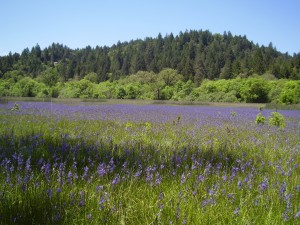 Why the Bypass is Bogus
Why the Bypass is Bogus
Caltrans Ignores Local Sensible Alternative Plans,
Bulldozing Forward with an Expensive, Ecologically Devastating
and Unnecessary Bypass for Willits
Ecological Considerations
- Caltrans Bypass project would entail the largest filling of wetlands in Northern California in 50 years. Placing huge amounts of fill dirt on top of wetlands will require that the ground below be drained and collapsed by the insertion of 55,000 wick drains. This will form an underground dam across the flood plain with unpredictable underground hydrological effects.
- The state Fish & Wildlife agency has already issued stop work orders several times to force Caltrans to comply with the Migratory Bird Treaty Act and the Northern California Water Board issued a violation recently.
- A conservative estimate of 95,000 tons of CO2 per year of construction will be released. That is a total of at least 380,000 tons over the construction period (probably a lot more). Caltrans claims that the Bypass will reduce CO2 emissions because it will reduce stop and go traffic. However, it will take 70-80 years for their calculated emissions savings to compensate for the construction impact.
- The construction of the Bypass (Phase 1 only) will require 1,400,000 cubic yards of fill, the largest fill permit the Army Corps of Engineers has issued in 50 years.
- Construction will require the use of haul roads through wetlands. While saying they would be “restored”, Caltrans has offered no explanation or plans for how these wetlands will be de-compacted and “restored” after completion of the Bypass (the possible success of which is highly controversial).
- Fishermen’s groups are concerned, as the proposed freeway would cross five salmon spawning creeks that feed into Outlet Creek, forming one of California’s longest Coho salmon runs. Caltrans’ mitigation scheme would require fish in Outlet Creek and its tributaries to be “relocated” for years during construction. One reason is that the noise from pile driving (1,600 piles )—reaching 185 to 220 decibels—would kill or maim any fish present. (A jet taking off is 140 decibels). The pile driving will go on 12 hours a day for 3 years.
- Tule elk, once common in Little Lake Valley, are now starting to be seen once more in the wetlands where the northern interchange for the freeway would be. Will they disappear again?
Community Considerations
- Caltrans has repeatedly and consistently refused to work together with members of the local community to resolve disputes – even with people strongly in favor of the Bypass but concerned about certain aspects of the design. Although initially in favor of the project, two County Supervisors now oppose it, and a Willits City Councilwoman recently traveled with activists to Sacramento to urge Gov. Brown to halt the plan.
- The Sherwood Valley Rancheria of Pomo Indians opposes the project and says that Caltrans did not follow the law with regard to tribal rights. Federal and state law requires Caltrans to consult with local native tribes to ensure protection of cultural sites during construction. Last week the tribe asked Caltans to cease ground disturbance in the project until they produce the cultural resource studies and reports on the project. The project site consists of one of the largest collections of burial and cultural sites, and have not been properly identified by Caltrans archaeologists, according to the tribe.
- 90% of local business owners/managers on Main St. have signed a petition voicing their opposition to the Bypass in its current design.
- A large chunk of the available farmland in the valley—2,000 acres out of a very small narrow valley—would be affected by this project, putting about a third of our available farmland out of production.
- This is not a single group trying to stop development; it is a broad coalition of ranchers, fishermen and -women, environmentalists, and 90 percent of local downtown business owners fighting a bureaucracy run amok.
- Cheaper, less damaging solutions have been proposed, most notably in a study co-sponsored by the Willits Chamber of Commerce, environmental groups, and the City of Willits. Alternative solutions could greatly reduce stop and go traffic for all vehicles passing through Willits – not just the 20-30% that would utilize the Bypass, reducing CO2 emissions.
Congestion Relief?
(The supposed agenda behind the Bypass)
- The Bypass will divert only 20-30% of traffic, including trucks. It will not eliminate stop and go traffic for at least 70% of the remaining traffic and will eliminate only a small part of congestion.
- An alternative solution could divert almost all truck traffic off of Main St. and virtually eliminate stop and go traffic entirely. Even Caltrans acknowledges that 70 to 80 percent of the traffic won’t use the new six-mile bypass:
- The projected future increase in traffic along the 101 corridor (used by Caltrans to justify the Bypass) has not been realized since predicted, and instead has even declined slightly.
Caltrans is an agency out of control, using our taxpayer money!
We believe the real agenda behind the Willits Bypass massive project, the proposed highway widening through Richardson Grove State Park, and a proposed project in the Smith River corridor is the drive to put an I-5 type of highway on the beautiful and fragile California coast. This agenda is largely fueled by pressure from the trucking industry and arrogance on the part of Caltrans because they have a guaranteed budget. But it’s our money!
Put the brakes on Caltrans!
→ Tell Jerry Brown and your state Reps in Sacramento you oppose the project!
→Support local groups Save Our Little Lake Valley & Earth First!
—————————————————————————————————————————————–
Bay Area Coalition for Headwaters ¸ 2530 San Pablo Ave., Berkeley, CA 94702 <bach@headwaterspreserve.org> Sign Up for (low volume) alerts at wwwHeadwatersPreserve.org

